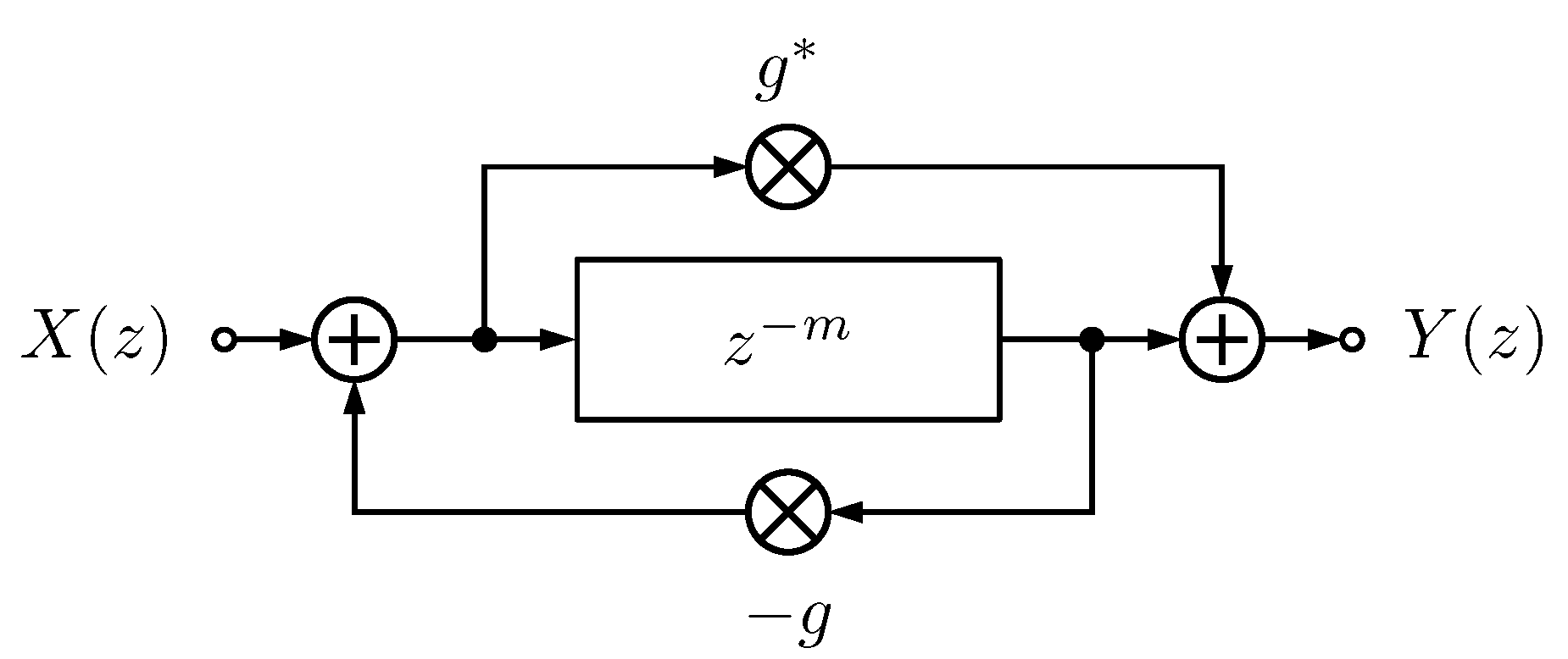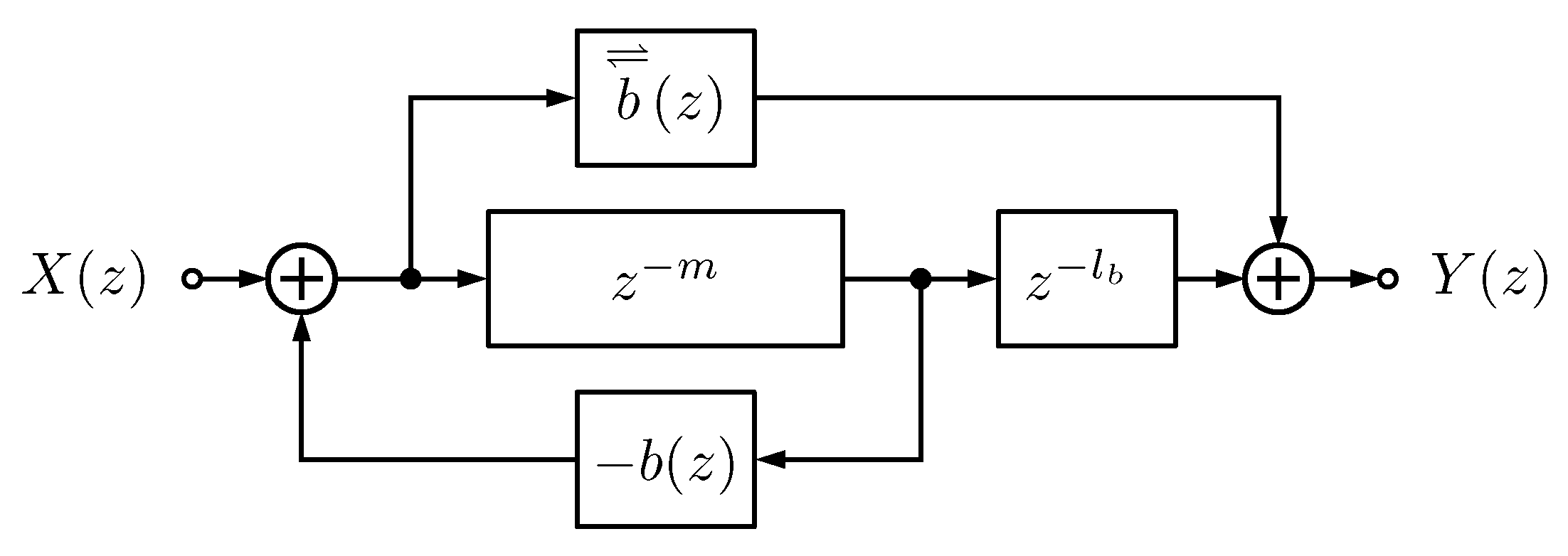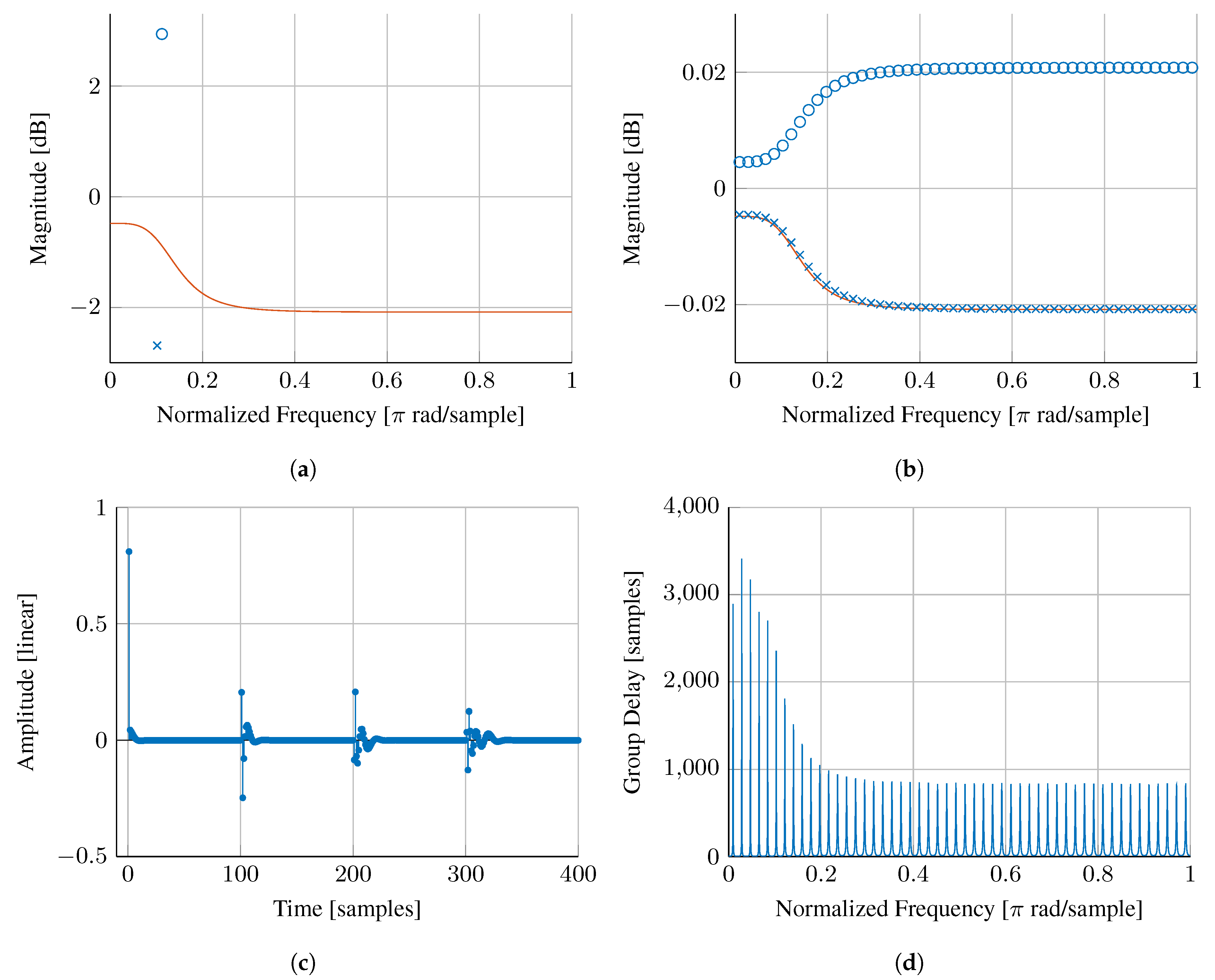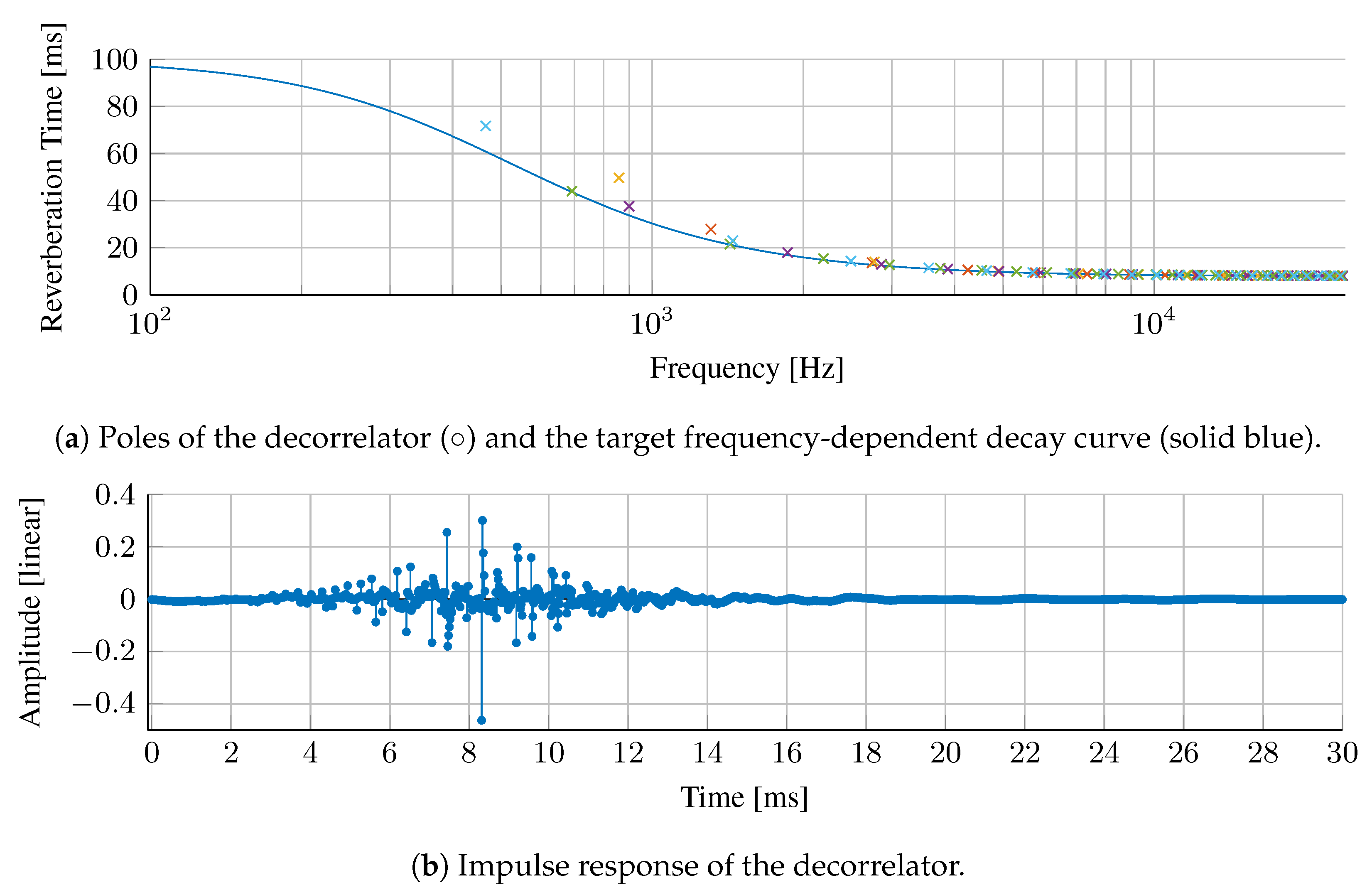Frequency-Dependent Schroeder Allpass Filters
Abstract
1. Introduction
2. Schroeder Allpass Filters
2.1. Filter Operations
2.2. General Allpass Filters
2.3. Classic Schroeder Allpass
2.4. Gerzon’s Allpass
2.5. Dahl’s Absorbent Allpass
3. Proposed Frequency-Dependent Schroeder Allpass
3.1. Filter Structure
3.2. Poles and Group Delay
3.3. Example
4. Application in Decorrelation
5. Conclusions
Funding
Conflicts of Interest
References
- Schroeder, M.R.; Logan, B.F. “Colorless” artificial reverberation. IRE Trans. Audio 1961, AU-9, 209–214. [Google Scholar] [CrossRef]
- Välimäki, V.; Parker, J.D.; Savioja, L.; Smith, J.O., III; Abel, J.S. Fifty years of artificial reverberation. IEEE/ACM Trans. Audio Speech Lang. Process. 2012, 20, 1421–1448. [Google Scholar] [CrossRef]
- Abel, J.S.; Smith, J.O., III. Robust Design of Very High-Order Allpass Dispersion Filters. In Proceedings of the International Conference Digital Audio Effects (DAFx), Montreal, QC, Canada, 18–20 September 2006; pp. 13–18. [Google Scholar]
- Gardner, W.G. A real-time multichannel room simulator. J. Acoust. Soc. Am. 1992, 92, 1–23. [Google Scholar] [CrossRef]
- Gerzon, M.A. Unitary (energy-preserving) multichannel networks with feedback. Electron. Lett. 1976, 12, 278–279. [Google Scholar] [CrossRef]
- Poletti, M.A. A Unitary Reverberator For Reduced Colouration In Assisted Reverberation Systems. In Proceedings of the INTER-NOISE and NOISE-CON, Newport Beach, CA, USA, 10–12 July 1995; Volume 5, pp. 1223–1232. [Google Scholar]
- Schroeder, M.R. Natural Sounding Artificial Reverberation. J. Audio Eng. Soc. 1962, 10, 219–223. [Google Scholar]
- Moorer, J.A. About this reverberation business. Comput. Music J. 1979, 3, 13–17. [Google Scholar] [CrossRef]
- Väänänen, R.; Välimäki, V.; Huopaniemi, J.; Karjalainen, M. Efficient and Parametric Reverberator for Room Acoustics Modeling. In Proceedings of the International Computer Music Conference, Thessaloniki, Greece, 25–30 September 1997; pp. 200–203. [Google Scholar]
- Dattorro, J. Effect Design, Part 1: Reverberator and Other Filters. J. Audio Eng. Soc. 1997, 45, 660–684. [Google Scholar]
- Dahl, L.; Jot, J.M. A Reverberator based on Absorbent All-pass Filters. In Proceedings of the International Conference Digital Audio Effects (DAFx), Verona, Italy, 7–9 December 2000; pp. 1–6. [Google Scholar]
- Lokki, T.; Hiipakka, J. A time-variant reverberation algorithm for reverberation enhancement systems. In Proceedings of the International Conference Digital Audio Effects (DAFx), Limerick, Ireland, 6–8 December 2001; pp. 28–32. [Google Scholar]
- Schlecht, S.J.; Habets, E.A.P. Time-varying feedback matrices in feedback delay networks and their application in artificial reverberation. J. Acoust. Soc. Am. 2015, 138, 1389–1398. [Google Scholar] [CrossRef]
- Kendall, G.S. The Decorrelation of Audio Signals and Its Impact on Spatial Imagery. Comput. Music J. 1995, 19, 71. [Google Scholar] [CrossRef]
- Boueri, M.; Kyriakakis, C. Audio Signal Decorrelation Based on a Critical Band Approach. In Proceedings of the Audio Engineering Society Convention 117, San Francisco, CA, USA, 28–31 October 2004. [Google Scholar]
- Kermit-Canfield, E.; Abel, J.S. Signal Decorrelation Using Perceptually Informed Allpass Filters. In Proceedings of the International Conference Digital Audio Effects (DAFx), Brno, Czech Republic, 5–9 September 2016; pp. 225–231. [Google Scholar]
- Canfield-Dafilou, E.K.; Abel, J.S. A Group Delay-Based Method for Signal Decorrelation. In Proceedings of the Audio Engineering Society Convention 144, Milan, Italy, 23–26 May 2018. [Google Scholar]
- Poletti, M.A. The Stability Of Multichannel Sound Systems With Frequency Shifting. J. Acoust. Soc. Am. 2004, 116, 853–871. [Google Scholar] [CrossRef]
- Schlecht, S.J.; Habets, E.A.P. The stability of multichannel sound systems with time-varying mixing matrices. J. Acoust. Soc. Am. 2016, 140, 601–609. [Google Scholar] [CrossRef]
- Välimäki, V.; Parker, J.D.; Abel, J.S. Parametric Spring Reverberation Effect. J. Audio Eng. Soc. 2010, 58, 547–562. [Google Scholar]
- Jot, J.M.; Chaigne, A. Digital delay networks for designing artificial reverberators. In Proceedings of the Audio Engineering Society Convention, Paris, France, 19–22 February 1991; pp. 1–12. [Google Scholar]
- Abel, J.S.; Canfield-Dafilou, E.K. Dispersive Delay and Comb Filters Using a Modal Structure. IEEE Signal Process. Lett. 2019, 26, 1748–1752. [Google Scholar] [CrossRef]
- Alary, B.; Politis, A.; Välimäki, V. Velvet-Noise Decorrelator. In Proceedings of the International Conference Digital Audio Effects (DAFx), Edinburgh, UK, 5–9 September 2017; pp. 405–411. [Google Scholar]
- Schlecht, S.J.; Alary, B.; Välimäki, V.; Habets, E.A.P. Optimized velvet-noise decorrelator. In Proceedings of the International Conference Digital Audio Effects (DAFx), Aveiro, Portugal, 4–8 September 2018; pp. 1–8. [Google Scholar]
- Vilkamo, J.; Neugebauer, B.; Plogsties, J. Sparse Frequency-Domain Reverberator. J. Audio Eng. Soc. 2012, 59, 936–943. [Google Scholar]
- Välimäki, V.; Reiss, J.D. All About Audio Equalization: Solutions and Frontiers. Appl. Sci. 2016, 6, 129. [Google Scholar] [CrossRef]









© 2019 by the author. Licensee MDPI, Basel, Switzerland. This article is an open access article distributed under the terms and conditions of the Creative Commons Attribution (CC BY) license (http://creativecommons.org/licenses/by/4.0/).
Share and Cite
Schlecht, S.J. Frequency-Dependent Schroeder Allpass Filters. Appl. Sci. 2020, 10, 187. https://doi.org/10.3390/app10010187
Schlecht SJ. Frequency-Dependent Schroeder Allpass Filters. Applied Sciences. 2020; 10(1):187. https://doi.org/10.3390/app10010187
Chicago/Turabian StyleSchlecht, Sebastian J. 2020. "Frequency-Dependent Schroeder Allpass Filters" Applied Sciences 10, no. 1: 187. https://doi.org/10.3390/app10010187
APA StyleSchlecht, S. J. (2020). Frequency-Dependent Schroeder Allpass Filters. Applied Sciences, 10(1), 187. https://doi.org/10.3390/app10010187




